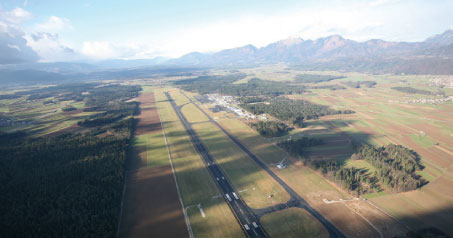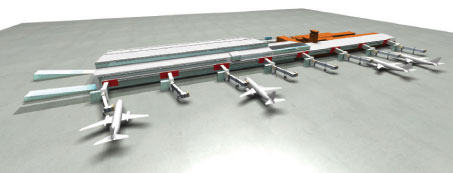
In January 2008, a 1,300m runway extension was completed, increasing its length to 3,300m. The project also included construction of two 170m taxiways and has nearly doubled runway capacity to around 25 movements per hour.
Slovenia entering the EU provided a great opportunity for Ljubljana Airport. The country is enjoying prosperous economic development in line with EU convergence levels. “We were able to gain positive effects out of it. The number of passengers and airlines has been growing since then,” explained Skobir. Market conditions concurrently became more complicated, with EU accession increasing competition with other airports in the region. “We became part of a big, domestic EU market. This competition existed in the past, but on an unfair basis, behind the borders of the EU,” said Skobir.

Ljubljana CEO Zmago Skobir: “The expansion of airport infrastructure is far from being over. In March, works will start to expand the main apron. The extended apron will have five parking spaces for larger cargo aircraft. At the same time an additional connecting taxiway will increase flow between the apron and runway.”
The impact has been predominantly positive. The 1.5 million passengers handled in 2007 is expected to grow 11% to almost 1.7 million in 2008. “The number of passengers has continued to grow for several years now. We expect throughput to increase to 2.2 million by 2015,” said Skobir. “Ljubljana will strive to increase the traffic generated by foreign tourists on low-cost carrier and charter flights in cooperation with the local tourist companies.” Skobir sees great potential for services to the UK and Scandinavia, as well as to Spain, Portugal and Italy, to which there are currently no direct connections with Ljubljana.
The key focus of Ljubljana’s development is on increasing both passenger and cargo traffic, as well as attracting aviation and logistics-related business. On the cargo side, the airport is striving primarily towards the development of a hub for the distribution of courier and parcel services coming from south-eastern Europe to western Europe via Ljubljana. While passenger numbers are expected to grow 11% in 2008, the volume of cargo handled is forecast to rise 17% to more than 25,000 tonnes.
Increased traffic has signalled expansion and upgrade of the existing facilities. Last year saw significant modernisation of handling equipment, particularly for cargo handling, as well as the opening of a terminal extension. In January 2008, a 1,300m runway extension was completed, increasing its length to 3,300m. The project also included construction of two €70m taxiways and has nearly doubled runway capacity to around 25 movements per hour.
Skobir described the opening of the terminal extension as the first step towards Ljubljana’s goal of becoming the region’s leading airport by 2015. “We will reach this goal through continued growth of passenger and cargo traffic, the construction of the new passenger terminal and the related airport infrastructure,” he said. The extension was designed by the Eko Art bureau, with construction undertaken by Slovenian construction company SCT. As part of the terminal extension a new upper floor was constructed, in which the departure lounges and immigration are located. The upper floor will later link the existing terminal to the new Terminal 2. The size of the departure lounge area was increased from 800sqm to 5,000sqm and there are four new passenger boarding bridges.
“Executing the entire project was very demanding because operations at the airport couldn’t be interrupted during the construction and all passenger and luggage safety standards needed to be maintained despite the work. Much of the work took place at night,” said Skobir. “The expansion of airport infrastructure is far from being over. In March, works will start to expand the main apron. The extended apron will have five parking spaces for larger cargo aircraft. At the same time an additional connecting taxiway will increase flow between the apron and runway.”
New Terminal 2

Ljubljana’s main investment this year is the new Terminal 2. Construction is scheduled to start in the second half of 2008 and the €60 million project will be complete in 2010. The terminal will have a capacity of 2.5 million passengers per year.
The airport’s main investment this year is undoubtedly the new passenger terminal. Construction is scheduled to start in the second half of 2008 and the €60 million project will be complete in 2010. Terminal 2 will have a capacity of 2.5 million passengers per year, or 850 movements per hour. “The terminal will provide rapid, effective and high quality implementation of passenger arrivals and departures, and border and Customs controls will be carried out in line with Schengen border standards,” said Skobir. The new terminal facilities comply with the Schengen criteria that Slovenia’s external borders must now meet. The airport’s infrastructure is now ready to ensure the separation of passenger traffic into Schengen and non-Schengen, with the new regime set to start in Slovenia in March 2008.
Skobir said: “The terminal will ensure quick, efficient and quality performance of the task of handling passengers and their luggage. There will be an automatic baggage sorting system and an additional four jetways will make boarding easier. Bigger space will enable more retail areas, more advertising sites and of course more comfort for our passengers. We will not forget all modern information technologies.”
SMAG participation
Skobir declared that Ljubljana will participate in ACI EUROPE’s Small and Medium Size Airports Action Group (SMAG). “The majority of European airports are those with traffic not exceeding two million passengers per year. It is time to hear their voice, along with the voice of the big hubs and regional airports. It will help to create better awareness that ‘no one size fits all’,” he said.
Slovenian EU Presidency priorities
The Slovenian Presidency, which began on 1 January 2008, has prepared a comprehensive six-month programme. The five key priorities are the launch of the new three-year cycle of the Lisbon strategy for growth and jobs; kicking-off the debate on the energy-climate package; reaffirmation of the European perspective for the Western Balkans and dealing with the Kosovo issue; ratification of the Lisbon Treaty and promoting the year of intercultural dialogue.
Maja Kocijancic, spokesperson, Slovenian EU Presidency, said: “Of course, these are not the only priorities of the Presidency – we also have many more sectoral goals. For us the challenge of the Presidency is enormous, but we believe that with ambition, enthusiasm, hard work and in close cooperation with our partners, we will be able to achieve what we have set out to do.”
In terms of the Presidency’s aviation agenda, the focus, said spokesperson Dragan Barbutovski, is on reaching “political agreement or even first reading agreement” on the European Commission’s proposed Directive on airport charges. Other aims include securing a general approach regarding the Regulation on Computerised Reservation Systems, as well as reaching Council Conclusions on the first report on the Single European Sky and the Communication on General and Business Aviation.







